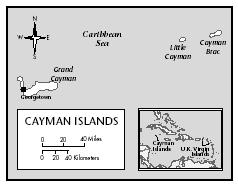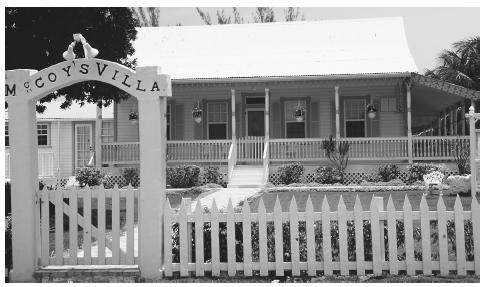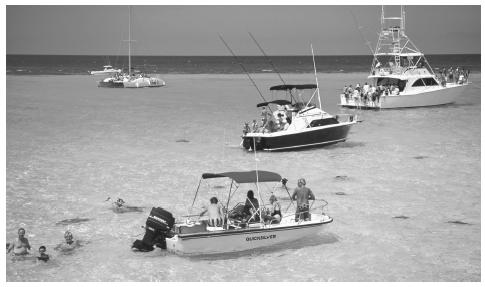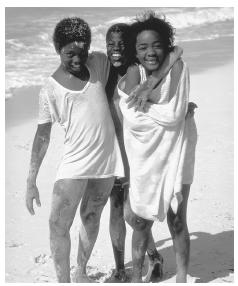Cayman Islands
Culture Name
Caymanian
Alternative Names
Crown Colony of the Cayman Islands; Caymans
Orientation
Identification. Christopher Columbus discovered the Cayman Islands on 10 May 1503 when his ships were blown off course by strong winds. He saw two small islands so full of turtles that he named them Las Tortugas, Spanish for "the turtles." It was the presence of the marine crocodile, however, that gave the islands their name, after the Carib word caymanas. The capital, George Town, was named after King George III of England.
Location and Geography. The three islands Grand Cayman, Little Cayman, and Cayman Brac lie in the Caribbean Sea about 200 miles (320 kilometers) northwest of Jamaica. Total land area is 100 square miles (264 square kilometers). The islands are outcrops of the Cayman Ridge, which extends from Cuba to Belize, and are formed primarily of limestone. Two of the deepest parts of the Caribbean, the Cayman Trough to the east and the Bartlett Trough to the south, together with the shallower Cayman Bank west of Grand Cayman lie in close proximity. Grand Cayman, the largest island, is approximately 22 miles (35 kilometers) long and 8 miles (13 kilometers) wide; its most striking feature is the North Sound, a shallow reef-protected lagoon. Cayman Brac, about 90 miles (145 kilometers) northeast of Grand Cayman, is about 12 miles (19 kilometers) long and a mile (1.6 kilometers) wide; its name derives from its most striking feature, the brac (Gaelic for "bluff") that runs the length of the island and drops 140 feet (43 meters) into the sea at its highest point. The flattest and least developed of the three islands, Little Cayman, lies about 5 miles (8 kilometers) west of Cayman Brac. There are no natural freshwater resources.
Demography. The population of 40,000 (2000 estimate) is diverse, with people of European stock comprising about 25 percent of the total, those of African descent another 25 percent, and the remaining 50 percent being of mixed ancestry. The capital, George Town (estimated population 35,000), is on Grand Cayman. According to 1999 estimates, the population growth rate is 4.2 percent. Women slightly outnumber men.
Linguistic Affiliation. English is the official language. A Creole language, Bay Islands English, is thought to have developed in the Caymans during the eighteenth century, and spread to islands farther west. Creole forms are more common on Cayman Brac and Little Cayman.
Symbolism. Turtles, pirates, and the British have all played a large part in the culture. The Department of Tourism combined the three when it chose a peg-leg "Sir Turtle" as a mascot and symbol for the country. The flag is blue, with the flag of the United Kingdom in the upper hoist-side quadrant and the Caymanian coat of arms on a white disk on the outer half of the flag. The coat of arms features a pineapple (a symbol of hospitality) and a turtle above a shield with three stars, representing the islands, and a scroll with the motto "He hath founded it upon the seas." Caymanians voted on new national symbols in 1996; the national flower is the wild banana orchid, the national tree is the silver thatch palm, and the national bird is the Cayman parrot.
History and Ethnic Relations
Emergence of the Nation. The islands became British following the Treaty of Madrid in 1670. During 1661–1671 settlers came from Jamaica; records show that Cayman Brac and Little Cayman

National Identity. The remoteness of the islands, and the social integration following the emancipation of slaves in 1835, resulted in a socially homogeneous society. Out of necessity, Caymanians relied on the sea. Shipbuilding and "sailorizing," the old term for seafaring, were important. They used local ingredients—coral fans for sieving flour, fish skins for scrubbing, the washwood plant for soap. The silver thatch palm was used for hats, baskets, roofs, and rope that was prized because it did not rot in saltwater and could be traded for other necessities. In the nineteenth century many of the locals left Cayman for jobs on neighboring islands and in Nicaragua, Honduras, and the southern United States; after World War II, a number of Caymanians left to work on ships, particularly oil tankers. These emigrants sent money and gifts home to relatives, continued to think of Cayman as home, and often returned after long periods abroad. There is a well-documented tradition of circular migration; the national anthem contains several references to "coming back to the island homeland" after traveling to distant cities. As late as the 1950s, the government's annual report stated that the main export was "seamen," and their remittances the mainstay of the economy. Persons of Caymanian descent, but born outside the islands, make up a significant part of the workforce today, and there is a strong feeling that the current immigration law should be changed to make it easier for these residents to obtain full Caymanian citizenship. Caymanians have resisted independence, and any hint that Britain may wish to divest itself of the islands is met with strong opposition.
Ethnic Relations. Relations between the various ethnic groups are good. There are no restrictions on applications for work permits, although current policy aims at insuring a balance among the various nationalities. The Immigration Board may restrict applications if any particular geographic category is thought to be excessive. The areas of friction do not involve ethnicity so much as who is entitled to citizenship. As of 2000, the islands had approximately ten thousand foreign workers, comprising almost a quarter of the population.
Urbanism, Architecture, and the Use of Space
Older houses were made from wattle and daub. Some cottages are raised off the ground, with large porches and gabled roofs. The local silver thatch palm, traditionally used for roofing, was supplanted by corrugated tin. Rainwater was collected from the roof and stored in a cistern beneath the house. Houses are usually painted in pastel colors of pink, turquoise, and green. "Sand gardens" are popular, decorated with native flowering plants and shells; at Christmas, it is traditional to bring white sand from the beach and spread it around the house to resemble snow.
The rapid growth in construction on Grand Cayman, which began during the 1980s to meet demand for new homes, hotels, and condominiums, has caused concern that the human dimension to urban design is being lost and that much of the island's architecture will eventually fall victim to new development. Efforts are being made to preserve some of the traditional landmarks, such as the Old Courts Building, one of the few surviving nineteenth century structures, and the Harry Piercy House, built in 1916 and recently renovated to become the National Museum offices. The Heritage Garden in the Queen Elizabeth II Botanic Park on Grand Cayman has a restored Caymanian farmhouse, complete with original furnishings, cook room, cistern, outbuildings, and fences and walls built of old coral.
Food and Economy
Food in Daily Life. Seafood is predominant. The traditional national dish is turtle; conch is also popular, either served raw with lime juice and onions, or cooked as a stew, chowder, or fritters. A number of recipes show influences from other Caribbean countries such as Jamaica and Trinidad. "Jerking," a slow-smoking process using a blend of spices, and "heavy cake," a dense sweet dessert made with "breadkind" (starchy vegetables such as cassava, papaya, and yams) are two examples. "Fish rundown" is fish stewed with "breadkind." "Swankie" is lemonade. Other common local ingredients include key limes, honey, rum, and coconut. A microbrewery produces beer for local consumption. Other than fish, turtle meat, and a few local fruits and vegetables, almost all food must be imported.
Food Customs at Ceremonial Occasions. At Christmas, beef (a luxury item) is featured, along with heavy cake and non-native fruits such as apples, pears, and grapes. Drinks based on corn, sorrel, and pineapple are also traditional during the holiday season.
Basic Economy. The country has the highest per capita income in the Caribbean—$23,800, according to a 1996 estimate. The economy is based largely on tourism and the islands' status as an offshore financial center. There is no business or personal income tax; legend has it that King George III of England granted this freedom from taxation, along with a permanent exemption from military service, as a reward for the islanders' heroism in saving British seamen wrecked off the coast in 1788. Major sources of government revenue include import duties, a tax of 7.5–10 percent on land or property transfers, a 10 percent tax on tourist accommodations, airport and cruise ship passenger departure fees, company registration fees, work permits, and business licenses. Inflation, which had been less than 3 percent for much of the 1990s, increased to over 4 percent in the first half of 2000. A stock exchange opened in January 1997. There is also a large shipping registry, with 1,080 ships registered as of 1997.
Land Tenure and Property. There are no restrictions on who may own property, although foreigners may own no more than two residences. As the government insures property titles, and all titles are registered, no title search or title insurance is needed. As of late 1999, the National Trust for the Cayman Islands owns 1,980 acres of nature reserves in perpetuity.
Commercial Activities. Tourism accounts for about 70 percent of the (GDP) and 75 percent of foreign currency earnings, with the bulk of the visitors from the United States. Tourist arrivals average about 1.2 million annually. The tourist industry is aimed at the luxury market.
The Caymans became an offshore banking center in the 1980s. More than six hundred banks are registered, with assets in excess of $500 billion, making the islands the fifth largest financial center in the world and a leader in the global eurocurrency market. Currently, at least forty of the world's top banks are represented. There are no exchange control or reporting requirements; deposits earn tax-free interest; funds can be moved in and out freely; and there is an excellent telecommunications system. The banking sector employs about a tenth of the labor force and contributes 16 percent of the GDP. Accusations of illegal activities, specifically "money laundering," have been leveled at some Cayman banks. In 1990 the Cayman Islands signed the Mutual Legal Assistance Treaty with the United States, and in 1996 enacted Britain's "proceeds of criminal conduct" law. Banks may now disclose information in cases of criminal activity (excluding tax-related matters), but there is still criticism of Caymanian banking in the international financial press.
Major Industries. Construction, the third major commercial activity, expanded in the 1980s to meet tourist accommodation demand, and labor had to be imported. Indications are that the rate of new construction slowed somewhat in 2000.
Trade. Major trading partners are the United States, Great Britain, Trinidad and Tobago, the Netherlands Antilles, and Japan. Exports include turtle products and manufactured consumer goods.
Division of Labor. The Immigration Law of 1992 gives preference in employment to those holding Caymanian status. Caymanians hold the majority of the clerical, secretarial, and lower management jobs. Foreign workers fall into two categories: temporary construction laborers hired during high-growth periods and professional and senior management staff in areas where there are no qualified locals available.
Social Stratification
Classes and Castes. The largely affluent, well-educated resident population mixes well, without racial problems or noticeable class distinctions.

Symbols of Social Stratification. Education is the primary factor in attaining high social status. It is seen as not only leading to better economic prospects, but also as enabling one to associate with people who are more cultured and conscious of upper-class values.
Political Life
Government. Formerly a dependency of Jamaica, the islands chose to remain a direct dependency of the British Crown when Jamaica achieved independence in 1962. The governor is appointed by the British Crown. An eight-member Executive Council advises the governor. Five of the council members (called ministers) are elected from the fifteen Legislative Assembly representatives. Three members are appointed by the governor: the chief secretary, who acts in the governor's absence; the financial secretary; and the attorney general. The Legislative Assembly is composed of two members from each of Cayman's six electoral districts, plus the three appointed members of the Executive Council.
There are no recognized political parties. Groups or "teams" of candidates run for office, and there is little or no difference in political ideology among them. In the November 2000 election, the National team, which had governed since 1992, was defeated in a surprise return to campaigning by independent candidates. There is universal suffrage, and the voting age is eighteen.
Leadership and Political Officials. Peter Smith was appointed governor in May 1999. There is a Cayman Islands representative to the United Kingdom. The late Jim Bodden, a legislative leader from the mid-1970s to the mid-1980s and founder of the International College of the Cayman Islands, was named the first "National Hero"; his statue stands opposite the assembly building in George Town.
Social Problems and Control. The most pressing social problems result from the rapid growth due to immigration. Caymanians now make up less than 50 percent of the workforce and are a bare majority of the population, as indicated by the 1999 census results. The country is a melting pot of nations and cultures (more than one hundred countries are represented); there is ongoing debate over who should be granted "Caymanian status" and allowed to live and work permanently in the Cayman Islands. Currently, foreigners must apply for a work permit that is valid for one year, which may be renewed.
Dependence upon tourism and finance puts Caymanians at the mercy of forces beyond their control. The islands' high standard of living, which is reflected in higher costs, may be contributing to a decline in tourism, as vacationers seek cheaper destinations. Cayman financial institutions have come under repeated scrutiny, criticism, and threats of tighter outside controls. The islands' economic welfare depends on these two sectors, so any decline in revenues would bring significant hardship.
Military Activity. The Royal Cayman Islands Police Force, first established in 1907, now has 266 officers.
Social Welfare and Change Programs
The Progress with Dignity team, which took control of the Legislative Assembly in 1984, emphasized greater government control of spending and development, and a social welfare approach to economic growth.
Nongovernmental Organizations and Other Associations
Concern about preserving Caymanian culture resulted in the establishment of the National Cultural Foundation, the National Museum, the National Trust, and the National Archive in the 1980s. An important part of the National Archive is the Memory Bank, an oral history program intended to preserve social history and culture via taped interviews with longtime residents.
There is an active Chamber of Commerce with members on Grand Cayman and Cayman Brac, and a number of business organizations, primarily in the tourism and financial services areas.
Gender Roles and Statuses
Division of Labor by Gender. Traditional society was matriarchal; Caymanian women took over in family, business, and government when the men went to sea. Starting in the 1930s, there was a growing feeling that women's roles and expectations had to change if the society was to progress. Women began to play more active roles in social and economic life. With the birth of trade unionism, women became important in the economic sphere, although the male-dominated society did not accept women as political equals.
The Relative Status of Women and Men. After World War II, universal adult suffrage resulted in women being grudgingly accepted as partners in the political process. Today, in the major businesses and social services, women play important roles; in the political arena, however, women are still under represented, making up just 26 percent of the candidates in the November 2000 election.
Marriage, Family, and Kinship
Marriage. Only monogamy is permitted. Homosexual acts are illegal, which has caused friction between the local Cayman authorities (especially the religious leaders) and Great Britain, which is pressing for liberalization throughout its territories. The pattern of circular migration meant that many men lived apart from their families for long periods, continuing to support them financially from abroad.
Domestic Unit. Households range from single persons (now most commonly expatriate workers) to single-parent families, traditional nuclear families, and extended family units with women usually predominating, both in numbers and in amount of control exercised within the family.
Inheritance. Property is inherited by descendants of the original owner; land is generally divided among the children.
Kin Groups. Family networks extend not only throughout the country but also overseas. Maintaining ties with relatives at home gives emigrants the possibility of a base should they decide to return. For those remaining on the islands, the relationships traditionally provided financial support, knowledge of distant events and cultures, and a place of temporary shelter should they also decide to emigrate.
Socialization
Infant Care. Child care is seen as the responsibility of the mother. During much of the islands' history, when men were obliged to be absent for long periods at sea, women stayed behind and received assistance from relatives.
Child Rearing and Education. Parents are expected to control their children's behavior. A high value is placed on education, which is free and compulsory to age sixteen; the literacy rate is 98 percent. At least one parent has been expected to be available to help students with homework, but recently there

Higher Education. Institutions of higher education are the Community College of the Cayman Islands, the International College of the Cayman Islands, and the Cayman Islands Law School.
Etiquette
There is a strong emphasis on politeness and modesty, partly due to the history of Cayman as a matriarchal society and partly due to the strong British influence. Handshaking is the usual greeting. A person may be introduced by his or her first name (such as "Mr. Tom" or "Miss Lucy"), because of the large number of people with similar surnames (such as Ebanks or Bodden). Unlike many tourist destinations, there is no "beach-hawking" culture; topless bathing is illegal, and wearing swimsuits off the beach is frowned on, although casual dress is acceptable. Homosexuality is illegal, and recent British government efforts to encourage liberalization in this area have been strongly opposed.
Religion
Religious Beliefs. The most important denomination is the United Church (Presbyterian and Congregational). Roman Catholic, Anglican, Baptist, and other Protestant denominations are also present. Sunday is a day of churchgoing, and visitors are welcome in most churches.
Religious Practitioners. Although women comprise the majority of the congregations, there has been resistance to allowing women to serve in positions of authority in the churches, and the majority of church leaders are male.
Rituals and Holy Places. No information is currently available on rituals and holy places in the Cayman Islands.
Death and the Afterlife. Family graveyards, where several generations were buried, have been supplanted by public cemeteries.
Medicine and Health Care
Health-care coverage is mandatory. Health facilities include a state-of-the-art hospital, opened on Grand Cayman in May 2000; a government health-care complex; and a medical clinic. Life expectancy for males is seventy-six years, for females, eighty-one

Secular Celebrations
Public holidays include: New Year's Day, 1 January; the Easter season holidays of Ash Wednesday, Good Friday, and Easter Monday; Discovery Day, the third Monday in May; the Queen's official birthday, a Monday in mid-June; Constitution Day, the first Monday in July; the Monday after Remembrance Sunday in November; Christmas Day, 25 December; and Boxing Day, 26 December.
The national festival, Pirates' Week, is the last week of October, and is celebrated with parades, regattas, fishing tournaments, and special events. The costume carnival of Batabano takes place on Grand Cayman during the last week of April or beginning of May; Cayman Brac has a similar celebration, called Brachanal, held a week after Batabano. Cayfest is the national arts festival, usually held during April, and features exhibitions, displays, dance, and drama.
The Arts and Humanities
Support for the Arts. Support for the arts comes from the government, private enterprise, community-based organizations, and individuals. The primary organization is the Cayman National Cultural Foundation (CNCF). Its projects have included hosting the Carib Art Exhibition and supporting Cayman's participation in CARIFESTA, the Caribbean Festival of Creative Arts.
Literature. Perhaps the best-known novel about Cayman life, Richard Matthiessen's Far Tortuga (1975) focuses on the life of a turtle boat captain and the relationship between man and nature in a changing society.
Graphic Arts. The most famous artist is Gladwyn Bush, known as "Miss Lassie," a fourth-generation Caymanian who began painting at the age of sixty-nine and has had exhibits in many countries. Her works, which she calls "markings," are painted not only on canvas but also on the walls, windows, and furnishings of her home, which is a local landmark on Grand Cayman. Other contemporary artists include Bendel Hydes and Kamal Singh Matthews. Local artists also work with such materials as coral, wood, limestone, and caymanite (multicolored limestone).
Performance Arts. The F.J. Harquail Theatre on Grand Cayman is the main venue for local and visiting companies. The CNCF provides training in the art of creating and staging plays through annual writing workshops, and stages performances of plays by local writers. Workshops are given in dance, drama, choral singing, and storytelling. "Gimistory," the Cayman Islands International Storytelling Festival, was established in November 1999 and is expected to become an annual cultural event.
Bibliography
Amit-Talai, Vered. "In Precarious Motion: From Territorial to Transnational Cultures." Canadian Review of Sociology and Anthropology 34 (3): 319–332, 1997.
Babiuk, Dale. "Canucks in the Caymans." CA Magazine 132 (2): 20-25, 1999.
George, Shurland, and Andrew F. Clark. "Tourism Educational and Training Policies in Developing Countries: A Case Study of the Cayman Islands (Caribbean)." Journal of Third World Studies 15 (1): 205–220, 1998.
Graham, William Ross. "Bay Islands English: Linguistic Contact and Convergence in the Western Caribbean." Ph.D. dissertation, University of Florida, 1997.
Maingot, Anthony P. The United States and the Caribbean, 1994.
McLaughlin, Heather R. Cayman Yesterdays: An Album of Childhood Memories, 1991.
——. "The Cayman Islands Memory Bank: Collecting and Preserving Oral History in Small Island Societies." Paper presented at the 65th IFLA Council and General Conference, Bangkok, Thailand, August 1999.
Meditz, Sandra W., and Dennis M. Hanratty. Islands of the Commonwealth Caribbean: A Regional Study, 1989.
Williams, Neville. A History of the Cayman Islands, 1970.
Web Sites
Island Connoisseur. Destinations: Cayman Islands. Electronic document. Available from http://www.caribbeansupersite.com/cayman
U.S. State Department. Background Notes: Cayman Islands, May 1996. Electronic document. Available from http://dosfanlib.uic.edu/ERC/bgnotes/wha/caymans9605.html
—S USAN W. P ETERS
FROM HOW IT WAS EXPLAINED TO ME IT SEEMED QUITE UNFAIR, HOW CAN ONE LIVE AND CONTRIBUTE TO A COUNTRY FOR SO MANY YEARS AND BE TOLD THEY HAVE TO LEAVE, WHAT ARE PEOPLE SOPPOSED TO WHEN THEY GO BACK TO THEIR HOME OF ORIGIN, WHEN NO PREPARATIONS HAVE BEEN MADE FOR THEM TO RETURN. i MAY BE GETTING THE WRONG END OF THIS ROLL OVER, COULD YOU CLARIFY THIS FOR ME, I WOULD BE GREATFUL.
long time ago ,when i was whatching a television program ,my name is ,jose garcia
( josagavi@yahoo.es )
Gayle Reynolds
gaylereynolds@comcast.net